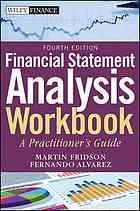(Ebook PDF) Financial statement analysis workbook 4th Edition by Fernando Alvarez, Martin Fridson 1118064207 9781118064207 Full chapter
$50.00 Original price was: $50.00.$35.00Current price is: $35.00.
Financial statement analysis workbook 4th Edition by Fernando Alvarez, Martin S Fridson – Ebook PDF Instant Download/Delivery: 1118064207, 978-1118064207
Full dowload Financial statement analysis workbook 4th Edition after payment

Product details:
ISBN 10: 1118064207
ISBN 13: 978-1118064207
Author: Fernando Alvarez, Martin S Fridson
Question-and-answer sections within this Workbook correspond to each chapter of Financial Statement Analysis, Fourth Edition. Part One (Questions) provides chapter-by-chapter fill-in-the-blank questions, as well as financial statement and computational exercises. They are designed to be thought-provoking and require analysis and synthesis of the concepts covered in the book. The answers to all questions, which can be found in Part Two, are provided in boldfaced italic type in order to facilitate the checking of answers and comprehension of material.
By enhancing your understanding of financial statement analysis, you can begin to undertake genuine, goal-oriented analysis and prepare for the practical challenges of contemporary business. This reliable resource will help you achieve such a difficult goal and allow you to make more informed decisions—whether you’re evaluating a company’s stock price or determining valuations for a merger or acquisition.
Financial statement analysis workbook 4th Table of contents:
Part One: Reading between the Lines
- Chapter 1: The Adversarial Nature of Financial Reporting
- The Purpose of Financial Reporting
- The Flaws in the Reasoning
- Small Profits and Big Baths
- Maximizing Growth Expectations
- Downplaying Contingencies
- The Importance of Being Skeptical
- Conclusion
Part Two: The Basic Financial Statements
-
Chapter 2: The Balance Sheet
-
The Value Problem
-
Comparability Problems in the Valuation of Financial Assets
-
Instantaneous Wipeout of Value
-
How Good is Goodwill?
-
Losing Value the Old-Fashioned Way
-
True Equity is Elusive
-
Pros and Cons of a Market-Based Equity Figure
-
The Common Form Balance Sheet
-
Conclusion
-
Chapter 3: The Income Statement
-
Making the Numbers Talk
-
How Real Are the Numbers?
-
Conclusion
-
Chapter 4: The Statement of Cash Flows
-
The Cash Flow Statement and the Leveraged Buyout
-
Analytical Applications
-
Cash Flow and the Company Life Cycle
-
The Concept of Financial Flexibility
-
In Defense of Slack
-
Conclusion
Part Three: A Closer Look at Profits
-
Chapter 5: What is Profit?
-
Bona Fide Profits versus Accounting Profits
-
What is Revenue?
-
Which Costs Count?
-
How Far Can the Concept Be Stretched?
-
Conclusion
-
Chapter 6: Revenue Recognition
-
Channel-Stuffing in the Drug Business
-
A Second Take on Earnings
-
Astray on Layaway
-
Recognizing Membership Fees
-
A Potpourri of Liberal Revenue Recognition Techniques
-
Fattening Earnings with Empty Calories
-
Tardy Disclosure at Halliburton
-
Managing Earnings with Rainy Day Reserves
-
Fudging the Numbers: A Systematic Problem
-
Conclusion
-
Chapter 7: Expense Recognition
-
Nortel’s Deferred Profit Plan
-
Grasping for Earnings at General Motors
-
Time-Shifting at Freddie Mac
-
Conclusion
-
Chapter 8: The Applications and Limitations of EBITDA
-
EBIT, EBITDA, and Total Enterprise Value
-
The Role of EBITDA in Credit Analysis
-
Abusing EBITDA
-
A More Comprehensive Cash Flow Measure
-
Working Capital Adds Punch to Cash Flow Analysis
-
Conclusion
-
Chapter 9: The Reliability of Disclosure and Audits
-
An Artful Deal
-
Death Duties
-
Systematic Problems in Auditing
-
Conclusion
-
Chapter 10: Mergers-and-Acquisitions Accounting
-
Maximizing Postacquisition Reported Earnings
-
Managing Acquisition Dates and Avoiding Restatements
-
Conclusion
-
Chapter 11: Is Fraud Detectable?
-
Telltale Signs of Manipulation
-
Fraudsters Know Few Limits
-
Enron: A Media Sensation
-
HealthSouth’s Excruciating Ordeal
-
Milk and Other Liquid Assets
-
Conclusion
Part Four: Forecasts and Security Analysis
-
Chapter 12: Forecasting Financial Statements
-
A Typical One-Year Projection
-
Sensitivity Analysis with Projected Financial Statements
-
Projecting Financial Flexibility
-
Pro Forma Financial Statements
-
Pro Forma Statements for Acquisitions
-
Multiyear Projections
-
Conclusion
-
Chapter 13: Credit Analysis
-
Balance Sheet Ratios
-
Income Statement Ratios
-
Statement of Cash Flows Ratios
-
Combination Ratios
-
Relating Ratios to Credit Risk
-
Conclusion
-
Chapter 14: Equity Analysis
-
The Dividend Discount Model
-
The Price-Earnings Ratio
-
Why P/E Multiples Vary
-
The Du Pont Formula
-
Valuation through Restructuring Potential
-
Conclusion
People also search for Financial statement analysis workbook 4th:
international financial statement analysis workbook
financial statement analysis workbook a practitioner’s guide pdf
a financial statement analysis report does not include
case study workbook financial statement analysis v2 1
mcgraw hill financial statement analysis
Tags:
Fernando Alvarez,Martin Fridson,Financial,statement,analysis,workbook 4th


